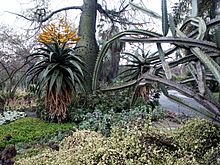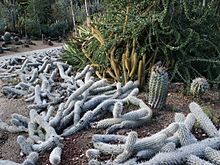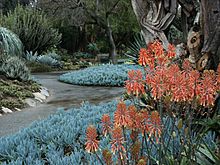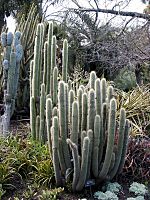Huntington Desert Garden facts for kids
Quick facts for kids Huntington Desert Garden |
|
|---|---|
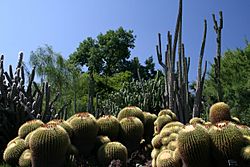
Mature Golden Barrel cacti with columnar ceroid cacti from South America
|
|
| Lua error in Module:Location_map at line 420: attempt to index field 'wikibase' (a nil value). | |
| Type | Public |
| Location | San Marino, California |
| Nearest city | San Marino, California |
| Area | 10 acres (4.0 ha) |
| Created | 1900s |
| Status | Open year round |
The Huntington Desert Garden is a super cool place in San Marino, California. It's part of a bigger spot called The Huntington Library, Art Collections and Botanical Gardens. This garden is one of the biggest and oldest collections of cacti and succulents anywhere! These amazing plants come from deserts all over the world. Many were brought here by Henry E. Huntington and William Hertrich, who was the garden's first expert. They traveled to North, Central, and South America to find these unique plants.
Contents
History of the Desert Garden
The Desert Garden is one of the most important gardens at The Huntington. It brought together many plants that people didn't know much about in the early 1900s. These plants are called xerophytes, which means they are super good at living in dry places. The Desert Garden became famous and is still one of the best in the world. It has over 5,000 different kinds of plants in its 10 acres (4 hectares).
How the Garden Started
Henry Huntington wasn't really a fan of cacti at first. He had some bad experiences with prickly pear cacti while building railroads! But William Hertrich, the garden's first expert, kept trying to convince him. Once Huntington changed his mind, he went all out! He even built a special railway track right to his garden. This made it easy to bring in tons of rocks, soil, and plants by train car.
As a later expert, Gary Lyons, once said, "it's very convenient to have a rail spur, and deep pockets, when you're building a big garden." In 1908, a trip to Arizona filled three whole train cars with plants for the garden!
A World-Famous Garden
A famous landscape designer from Brazil, Roberto Burle Marx, once called the Huntington Desert Garden "the most extraordinary garden in the world." That's a huge compliment!
Amazing Plants in the Desert Garden
The Desert Garden has many special collections of plants. Some of the most important groups include agaves, aloes, bromeliads, cacti, and euphorbias. There are also cool plants like echeverias, crassulas, and sedums.
Agaves and Yuccas
The collections of agave and yucca plants are very important for research. The Huntington has the biggest Yucca filifera in the whole world! You can also see some of the oldest Ponytail "Palms" (which are actually part of the agave family, not true palms). These were some of the first plants put in the Desert Garden.
Awesome Aloes
The garden has one of the largest collections of Aloes outside of Africa. There are about 200 different kinds of aloes here, out of 300 species in the world! Most of them come from southern Africa. The Aloe arborescens puts on a fiery red flower show in winter. The Aloidendron barberae (also known as Aloe bainesii) is super tall, growing up to fifty feet high!
Pretty Puyas
Puyas are a type of bromeliad that grows on the ground. They create a spectacular display of flowers in April and early May.
Cool Columnar Cacti
Most of the tall, column-shaped plants in the desert garden are from the Cereus family. They give the garden its unique look. These cacti grow flowers in late summer and colorful fruit in September and October. The Cereus xanthocarpus is the heaviest plant in the garden, weighing twenty tons! This tree-like cactus was already big when it was planted in 1905. It's about 125 years old now.
Golden Barrel Cacti
One of the most amazing sights is the collection of 500 bright yellow-spined Golden Barrel Cacti (Echinocactus grusonii). The biggest ones are over 85 years old! They bloom in the spring and are originally from central Mexico. This is probably the best collection of Golden Barrels anywhere in the world.
Crassula Family Plants
The crassula family includes many plants with thick, fleshy leaves. Most of these are found in Mexico and Africa. When autumn arrives, their leaves turn beautiful pastel colors. Look for plants like aeonium, echeveria, kalanchoe, pachyphytum, and sedum.
Euphorbias: Cactus Look-Alikes
In the African section of the garden, you'll see plants that look like columnar cacti but are actually succulent spurges (Euphorbia). They have a milky sap that can be irritating. Most of these species come from South Africa and East Africa. The Crown of Thorns (Euphorbia milii), a common house plant, is a spiny plant from Madagascar that has colorful "flowers" (actually bracts) all year long.
Strange Boojum Trees
The weird-looking boojum trees (Fouquieria columnaris) are rare and unique. They come from Baja California. The more common ocotillo (F. splendens) is also in the garden. The main part of the garden has many fouquierias from Mexico with bright red flowers for most of the year.
Living Stones
The garden has the largest collection of living stones in America. These are tiny plants from southern Africa that belong to the genus Lithops. They look just like small stones!
Caudiciform Plants
The collection of caudiciform plants is also very special. These plants have super thick stems that can look like twisted sweet potatoes. This thick stem, called a caudex, stores water for the plant. The garden has a huge Dioscorea elephantipes specimen.
Desert Garden Gallery
-
Aloe marlothii in bloom, with Ceiba speciosa and euphorbia -
Creeping Devils (Stenocereus eruca), with Fouquieria and barrel cacti -
A group of mature Golden Barrels (Echinocactus grusonii) showing their distinctive clustering habit. The Golden Barrel collection at the Huntington may be the finest in the world. -
Golden Barrels with Senecio mandraliscae, Blue Stick or Blue Finger succulents
See also
 In Spanish: Huntington Desert Garden para niños
In Spanish: Huntington Desert Garden para niños


